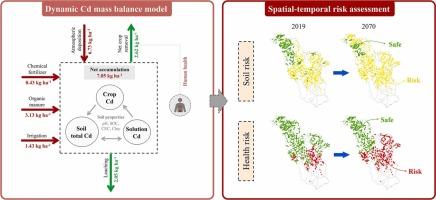Model-based spatio-temporal cadmium health risk assessment by rice consumption and management at regional scale in China
IF 11.3
1区 环境科学与生态学
Q1 ENGINEERING, ENVIRONMENTAL
引用次数: 0
Abstract
Cadmium (Cd) accumulation in agricultural soils and its transfer to crops pose significant health risks to humans. To identify high-risk areas and guide regional management, this study conducted a spatio–temporal assessment of Cd fluxes and pollution risks in rice systems, based on a systematic 5-year survey (2014–2019) in a typical agricultural county in southern China. The model accurately simulated historical changes in soil total Cd content across 56 paddy sites, with an average annual increase of 3.4 μg kg⁻¹. Atmospheric deposition contributed 63% of total soil Cd inputs and crop harvesting accounted for 56% of total outputs, with 25% of the rice area currently exceeding the national food safety standard. If no mitigation measures are taken this area would increase to 74% by 2070, with over 87% of farmlands falling into Cd pollution risk zones. Rice from 52% of the farmlands would pose non–carcinogenic health risks to the surrounding population. The risks are particularly high in the eastern and western regions, with children (56%) being more affected than adults (48%) due to greater Cd intake. To mitigate further Cd pollution, targeted Cd source control areas and improvement of soil properties are essential. The study demonstrates the potential of a site–specific dynamic Cd pollution model to assist decision makers in formulating policies to reduce Cd pollution at regional level.

基于模型的中国水稻消费与管理镉时空健康风险评价
镉(Cd)在农业土壤中的积累及其向作物的转移对人类健康构成重大风险。为了识别高风险区域,指导区域管理,本研究在中国南方典型农业县5年系统调查(2014-2019)的基础上,对水稻系统Cd通量和污染风险进行了时空评估。该模型准确地模拟了56个水稻点土壤总镉含量的历史变化,平均每年增加3.4 μ kg⁻¹。大气沉降占土壤Cd总投入的63%,作物收获占总产量的56%,目前有25%的水稻面积超过国家食品安全标准。如果不采取缓解措施,到2070年,这一比例将增加到74%,超过87%的农田落入镉污染危险区。来自52%农田的水稻将对周围人口构成非致癌性健康风险。东部和西部地区的风险尤其高,儿童(56%)比成人(48%)受镉摄入的影响更大。为了进一步减轻镉污染,有针对性的镉源控制区和改善土壤性质是必不可少的。该研究证明了特定地点动态Cd污染模型的潜力,可以帮助决策者制定减少区域层面Cd污染的政策。
本文章由计算机程序翻译,如有差异,请以英文原文为准。
求助全文
约1分钟内获得全文
求助全文
来源期刊

Journal of Hazardous Materials
工程技术-工程:环境
CiteScore
25.40
自引率
5.90%
发文量
3059
审稿时长
58 days
期刊介绍:
The Journal of Hazardous Materials serves as a global platform for promoting cutting-edge research in the field of Environmental Science and Engineering. Our publication features a wide range of articles, including full-length research papers, review articles, and perspectives, with the aim of enhancing our understanding of the dangers and risks associated with various materials concerning public health and the environment. It is important to note that the term "environmental contaminants" refers specifically to substances that pose hazardous effects through contamination, while excluding those that do not have such impacts on the environment or human health. Moreover, we emphasize the distinction between wastes and hazardous materials in order to provide further clarity on the scope of the journal. We have a keen interest in exploring specific compounds and microbial agents that have adverse effects on the environment.
 求助内容:
求助内容: 应助结果提醒方式:
应助结果提醒方式:


